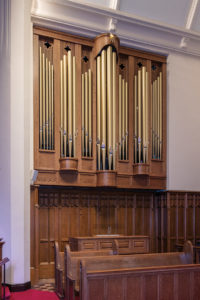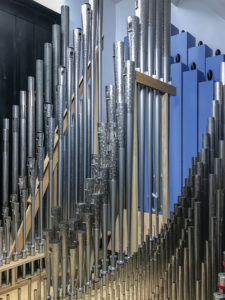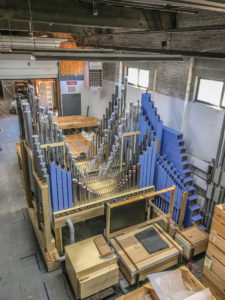 Two Tales of Two-Manual Organs
Two Tales of Two-Manual Organs
By Patrick J. Murphy
View an enlarged cover
Stop List
Organbuilders dream about having the opportunity to construct fine large instruments that stunningly display their creative ethos. The realities of today’s market, however, more often challenge builders to create highly flexible instruments in very limited spaces and budgets. Many congregations give in to these limitations easily, threatening the extinction of quality music in their worship life. But there are many parishes, even small ones, that understand the value of quality music in their services and find ways to overcome the perceived limitations. Patrick J. Murphy & Associates recently had the fortunate opportunity to provide modest instruments for two of these churches, allowing them to continue building up their heritage of fine liturgical music.
Saint John Evangelical Lutheran Church
Carnegie, Pennsylvania

Located in suburban Pittsburgh, Saint John Evangelical Lutheran Church is just a few blocks away from our successful installation at Saint Elizabeth Ann Seton Roman Catholic Church. It was at a chance visit to Saint Elizabeth’s that Saint John’s organist, Jeffrey H. Gray, was accompanied by Nancy J. McBurney. After hearing our work at Saint Elizabeth’s, she expressed her desire for such an instrument at Saint John’s. Ms. McBurney left a generous bequest to the church that upon her passing made Opus 65 possible. The final specification was produced in collaboration with Jeff Gray.
This three-manual, 17-rank instrument is located in the northeast chamber that has housed all previous instruments, and serves a room that seats approximately 300 people. Careful engineering allowed us to lay out a well-developed two-manual instrument in the rather limited chamber space. We expanded the usefulness of those resources by including a third manual that makes it easy to solo out selected stops. All-electric windchests facilitate giving the organist that requested tonal flexibility.

All stops are enclosed except for the Great Principal 8′ and Octave 4′ and the Pedal 16’/8′ units. Larger scaling with unforced voicing provide a conservative English-leaning ensemble that produces a warm buildup to a Mixture that gently caps the chorus. As is often the case, retention of worthy existing pipework from the previous instrument proved to be a responsible choice. Three stops were retained from the previous Wicks instrument and revoiced to make them fit seamlessly into the new tonal scheme. The Pedal Principal was extended to be playable on the Solo manual. New chorus fluework was designed by PJM and constructed by Organ Supply Industries.
New reeds from A.R. Schopps include a fine Trompette unit constructed with wide German shallots for the Haskell 16′ and 8′ octaves and modified parallel shallots for the treble. This provides the dual function of Pedal gravity in the lower range and manual ring through the treble compass.

In tonal finishing, the focus was to balance the resources in a way that would maximize the flexibility of registration. Imaginative combining of stops that might not ordinarily be used together is here encouraged. Though the sound of full organ is not at all timid, extremes on both ends of the dynamic range have been restrained.
Our signature low-profile movable English drawknob console with Peterson’s “integrated control system” enhances the flexibility and portability within this small chancel location.


Grace Lutheran Church
Astoria (Queens), New York

Located just ten minutes from New York’s busy LaGuardia Airport, Grace Lutheran Church is part of the laid-back Astoria neighborhood in the borough of Queens. This multicultural area of low-rise residences and small businesses is bounded by the East River and the famed Hell Gate railroad bridge. Grace Lutheran Church is a modest building constructed in the first quarter of the 20th century with seating for about 150 people. Just a few blocks from the famed Steinway factory, the parish is also home to a well-attended K–8 school.
Our Opus 64 replaces a 1932 Möller of two manuals and ten stops. With the exception of retaining two pedal stops from the Möller organ, this is an entirely new instrument. Cleverly installed in a space-challenged southeast chamber, all stops are under expression except for the Great 8′ Principal, which comprises the facade. The church also undertook much-needed renovations to the chamber to provide better temperature control as well as improved tonal egress. Our signature low-profile terraced console, all-electric windchests, and new tonal scheme are wonderfully complemented by our neo-Classic case.

The 8′ Principal is scaled and voiced to be leaner in sound than is our standard but is no less effective within this curiously tricky acoustic. The mixture is conservative and based on examples of E. & G.G. Hook, whereas the 2′ is obtained directly from the three-rank mixture. The breaks occur at notes 25 and 37. The array of flute stops provides color and thickening effects to carry in this small room. For an organ of this size, it is a luxury to include two reed stops. The haunting Oboe, with its lifting caps, is partnered with a snappy but not crass Trompette that extends into the Pedal, developing increasingly fundamental tone as it descends to 16′ C. Haskell reed construction made it possible to fit a full-length 16′ into the severely limited space. New fluework was constructed by Organ Supply Industries.

The challenge was to provide a suitable, year-round, solid, liturgically based instrument that can support not only congregational singing and choral accompaniment but also a reasonable portion of the larger organ literature. Our sincerest thanks to organist and director of music Henry Lee for his excellent guidance and musical oversight and to Pastor James Klockau for his unwavering support in this project.
As with all of our projects, all mechanicals—console, windchests, construction chassis, tonal direction, and engineering—were produced in-house by our committed team of talented craftspersons. Voicing and finishing for both projects was performed on site as a collaborative effort between our former tonal director Fredrick Bahr and present voicer Megan Farrell.
PJM STAFF
Matt Farrell: project foreman, winding, installation
Mark Tenreiro: engineering, case design, woodworking, installation
Jon Carmichael: woodworking, production, installation
Matt Jones: electrical wiring, console, installation
Chris Mills: production, winding, wiring
John Conner: woodworking, production
Megan Farrell: voicing, pipework preparation
Kitty Greer: office manager
Patrick Murphy is president and artistic director of PJM & Associates Organbuilders.
All photos of Saint John project by Philip Maye of Illuminating Studios Photography
All photos of Grace Lutheran project by Patrick J. Murphy


